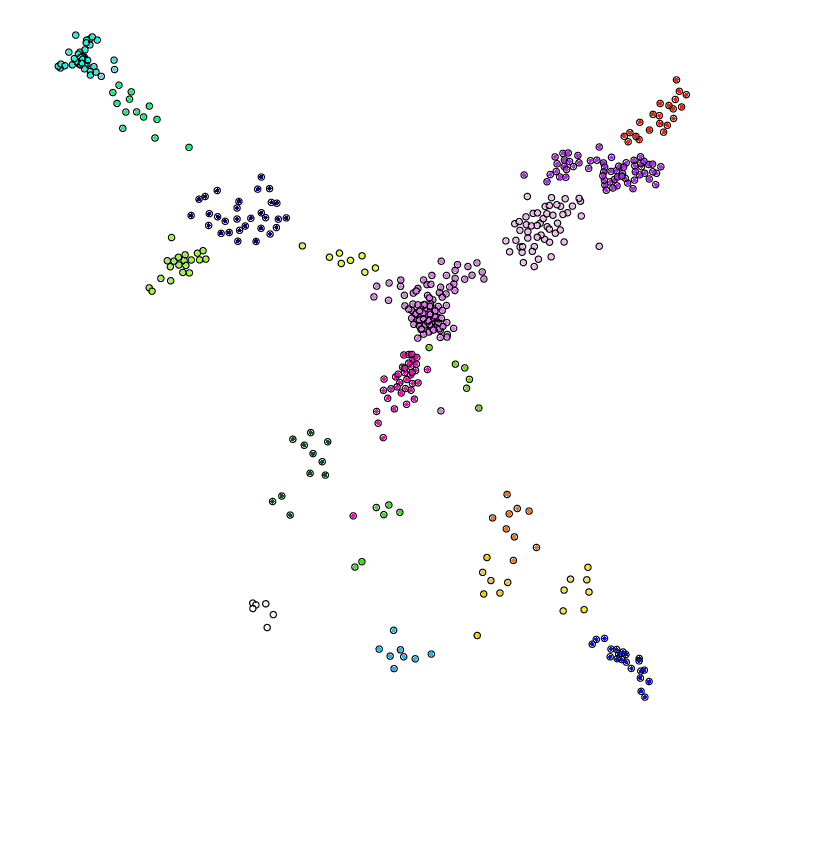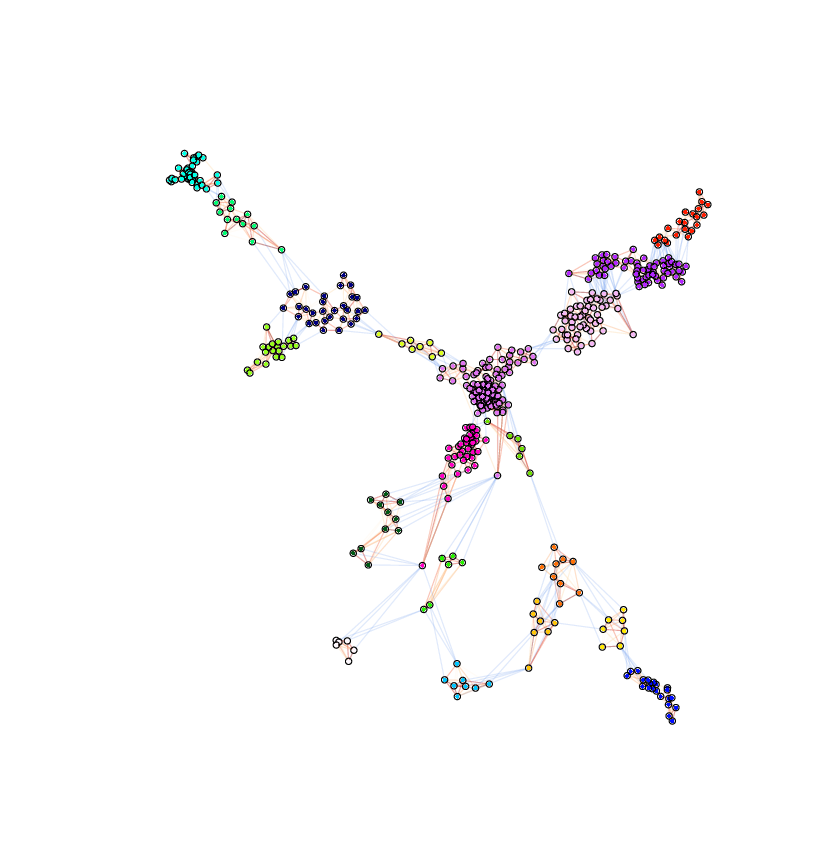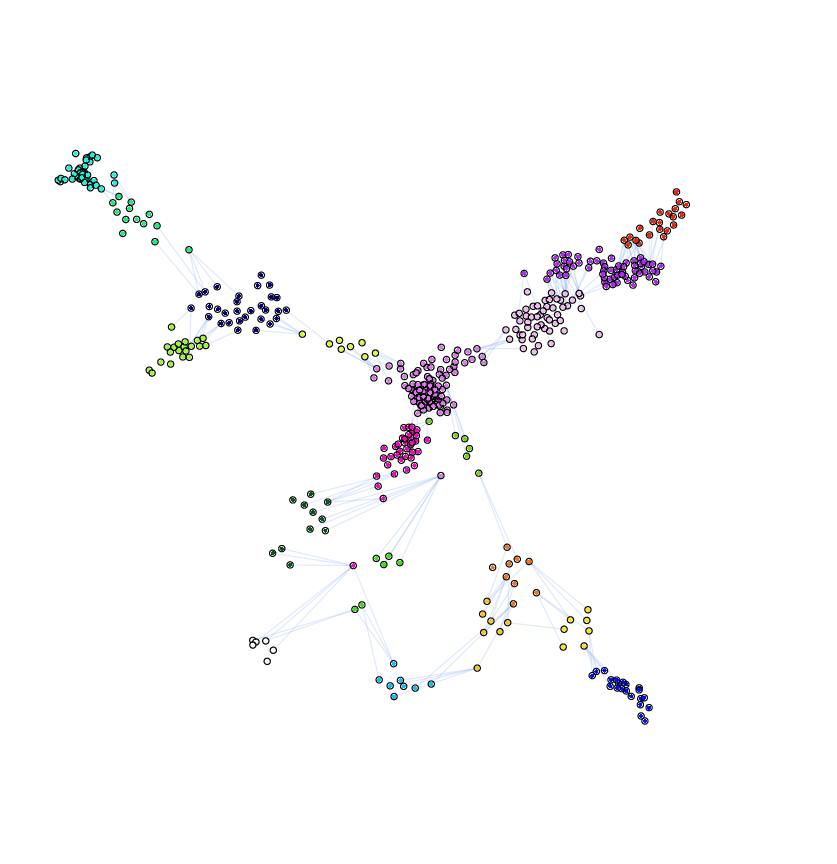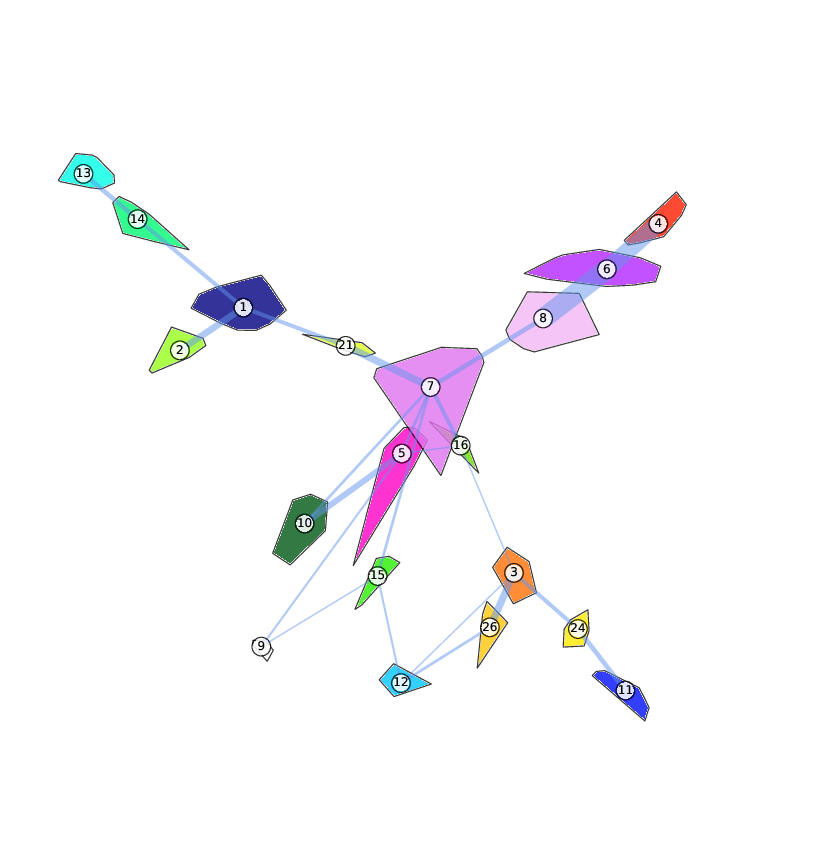Compute a 2D embedding of a data matrix given supervised class information.
A discrete label for each instance is expected. A graph is built where nodes are instances and there exist two types of edges: the 'knn' edges and the 'k_shift' edges. A knn edge is an edge to the k-th nearest instance that has the same label. A k_shift edge is an edge to the k-th nearest instance that is denser and has a different label. Density is defined as the sum of the pairwise cosine similarity between an instance and all the other instances. The desired edge length is the euclidean distance between the instances. If the endpoints of an edge have the same label then the desired distance is divided by 1 + class_confidence. A k-shift edge is deleted if at least one of the endpoints is an outlier. Outlier nodes are defined as those instances that have no mutual k neighbors.
Finally the embedding is computed as the 2D coordinates of the corresponding graph embedding using the force layout algorithm from Tomihisa Kamada, and Satoru Kawai. "An algorithm for drawing general undirected graphs.", Information processing letters 31, no. 1 (1989): 7-15.
Here is a link to the interactive jupyter notebook (needs to be run locally).
GraphEmbed can be installed via PyPI:
# a non pip dependency is graphviz, you can install this e.g. via
conda install pygraphvizpip install graphembedA python2 version of GraphEmbed can be installed via conda:
conda install graph_embed -c biocondaYou can execute the program by typing:
./graph_embed.py -i example/prot_expression.csv -t example/target.csv
You can change the strength of the belief in the supervised information. Values higher than 0 indicate a stronger belief and will result in more compact layouts for instances of the same class. Values of 0.5-1 are suitable for clean data where clusters are naturally well separated, values of 5-30 are suitable for noisy data where it is necessary to force a strong separation in the 2D representation.
To set a desired separation strength use -c, to specify the number of neighbors use -k:
./graph_embed -i example/prot_expression.csv -t example/target.csv -c 1.5 -k 5 -z 10 -l 0 --random_state 2 --normalization --correlation_transformation --feature_selection
The option -o allows to set a directory where the produced files are placed. The directory name is suffixed with a time stamp that includes year-month-day-hour-min-sec. The following files are produced:
2D_coords.txt The 2D coordinates, one line per instance
target.txt The target identifier, one line per instance
img_1_clean.pdf The image of the 2D embedding.
img_2_edges.pdf The image of the 2D embedding with lines in red for knn edges and lines in blue for k-shift-edges.
img_3_edge.pdf The image of the 2D embedding with lines in blue for the first shift-edges.
img_4_hull.pdf The image of the 2D embedding with class convex hulls and edges proportional to the num of first shift-edges across classes.
img_5_hull_link.pdf The image of the 2D embedding with class convex hulls and first shift-edges.
log The program execution log file
Version: 2.4
Author: Fabrizio Costa [costa@informatik.uni-freiburg.de]
Usage:
graph_embed.py -i <file> -t <file> [-o NAME]
[-c N, --class_confidence=N] [-k N] [-d N] [-z N] [-l N]
[--correlation_transformation] [--normalization]
[--feature_selection]
[--min_threshold=N] [--max_threshold=N] [--random_state=N]
[--display] [--figure_size=N] [--cmap_name=NAME]
[--verbose] [--do_not_add_timestamp]
graph_embed (-h | --help)
graph_embed --version
Options:
-i <file> Specify input data file in CSV format.
-t <file> Specify classes data file in CSV format.
-o NAME Output directory name [default: out].
-c N, --class_confidence=N Confidence bias for clustering
[default: 1.0].
-k N Number of links towards closest neighbors
with same class [default: 3].
-d N Number of links towards denser neighbors
with a different class [default: 1]
-z N Number of nearest neighbors to limit the
horizon where to search for denser
neighbors of a different class [default: 5]
-l N Number of mutual nearest neighbors that
define outlier instances [default: 3]
--normalization Convert data matrix to normalized matrix.
--feature_selection Select most discriminative features.
--correlation_transformation Convert data matrix to corr coeff matrix.
--min_threshold=N Min num instances per class [default: 5]
--max_threshold=N Max num instances per class [default: 300]
--random_state=N Random seed [default: 1]
--display Display graphs on terminal.
--figure_size=N Figure size [default: 15].
--cmap_name=NAME Color scheme [default: gist_ncar].
--do_not_add_timestamp Do not use timestamp as suffix for
output directory name.
-h --help Show this screen.
--version Show version.
--verbose Print more text.
The image of the 2D embedding.
The image of the 2D embedding with lines in red for knn edges and lines in blue for k-shift-edges.
The image of the 2D embedding with lines in blue for the first shift-edges.
The image of the 2D embedding with class convex hulls and edges with thickness proportional to the number of shift-edges across classes (effectively, num - 1 to account for potential random single link).
The image of the 2D embedding with class convex hulls and edges in blue for the first shift-edges..




